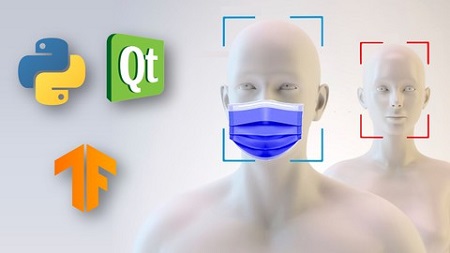
English | MP4 | AVC 1280×720 | AAC 44KHz 2ch | 4 Hours | 0.97 GB
Learn Face Recognition for Face Mask Detection using Python, TensorFlow 2, OpenCV, PyQT, Qt
I will start the course by installing Python and installing the necessary libraries in Python for developing the end-to-end project. Then I will teach you one of the prerequisites of the course that is image processing techniques in OpenCV and the mathematical concepts behind the images. We will also do the necessary image analysis and required preprocessing steps for the images. Then we will do a mini project on Face Detection using OpenCV and Deep Neural Networks.
With the concepts of image basics, we will then start our project phase-1, face identity recognition. I will start this phase with preprocessing images, we will extract features from the images using deep neural networks. Then with the features of faces, we will train the different Deep learning models like Convolutional Neural Network. I will teach you the model selection and hyperparameter tuning for face recognition models
Once our Deep learning model is ready, will we move to Section-3, and write the code for preforming predictions with CNN model.
Finally, we will develop Flask API and make prediction to live video streaming.
What are you waiting for? Start the course develop your own Computer Vision Flask Web Project using Machine Learning, Python and Deploy it in Cloud with your own hands.
What you’ll learn
- Face Recognition for Mask detection with Deep Learning
- Develop Convolutional Network Network for Face Mask from Scratch using TensorFlow
- Preprocess the big data of image
- OpenCV for Face Detection
Table of Contents
Introduction
1 Introduction
Setting Up Project
2 Install Python
3 Create Virtual Environment in Python
4 Install Libraries like TensorFlow 2, OpenCV etc.
Data Preparation & Preprocessing
5 Download Resources
6 Data
7 Data Preparation Process
8 Data Preparation Import Required Python Libraries
9 Data Preparation Get all Images Path in Folder
10 Data Preparation Labeling
11 Data Preparation Get Images Path and Labelling Images in multiple Folders
12 Step – 3, Face Detection
13 Face Detection Read Image
14 Face Detection Load Model
15 Face Detection Blob from Image
16 Draw Bounding Box for Detected Face
17 Step – 4, Crop the Detected Face
18 Step – 5, Image Processing – Blob from Image (RGB mean subtraction image)
19 Step – 5, Image Processing – Rotate & Flip Image
20 Step -5, Remove Negative values and Normalize
21 Apply Data Preparation process to All images
22 Step – 6, Save Preprocessed Data in Numpy zip
Face Recognition Model for Mask Identification with Deep Learning
23 Load Numpy Zip Data into Notebook
24 One Hot Encoding to target or output variable (y)
25 Split the Data into Train and Test sets
26 Convolutional Neural Network Architecture
27 Develop CNN model in TensorFlow 2
28 Compile CNN model, Setting Adam Optimizer & Loss Function
29 Train CNN model
30 Save Deep Learning Model in TensorFlow
Predictions with Face Recognition model for Face Mask
31 Load TensorFlow based CNN Model in a Notebook
32 Defining Labels and Setting Colors
33 Step – 1, Face Detection
34 Step -2, Data Preprocess
35 Step – 3, Get Predictions from CNN Model for Face Mask
36 Generate text for Prediction info
37 Get Face Mask Prediction to an Image
38 Real Time Face Mask Prediction
PyQt Basics
39 What you will Develop
40 Install Visual Studio Code
41 Setting Up Project
42 Install PyQt and Connect VS code to Virtual Environment
43 PyQt Background
44 Your First PyQt App with QtWidgets
45 Qt Template
46 QtWidgets
47 QWidget
48 QLabel
49 QLineEdit
50 QPushButton
51 QComboBox
52 Placing & Arranging Widgets
53 Placing Widgets using QHBoxLayout and QVBoxLayout
54 Signals and Slots
55 Backend Operations in PyQt
Desktop App with PyQt
56 What you will develop
57 Setting up Visual studio code
58 Create Main Window
59 PyQT Front End Design of Desktop App
60 Face Mask Desktop App using PyQt
BONUS
61 Bonus Lecture
Resolve the captcha to access the links!